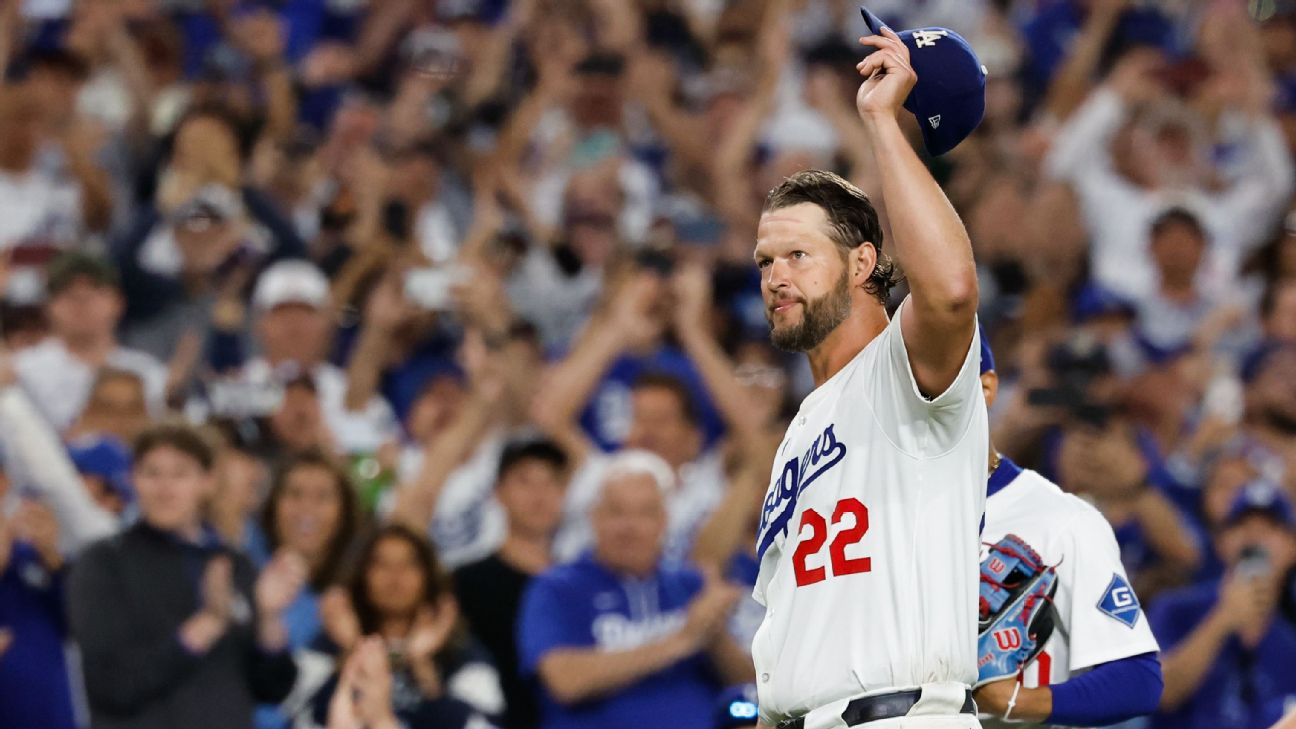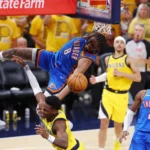Baseball history was made on a recent Wednesday at Dodger Stadium. Clayton Kershaw, the iconic left-handed ace for the Los Angeles Dodgers, etched his name into an exclusive record book.
In the sixth inning of a game against the Chicago White Sox, Kershaw whiffed Vinny Capra, recording his 3,000th career strikeout. This monumental achievement made him the “20th pitcher in baseball history to reach that milestone,” firmly cementing his legacy among the game’s all-time greats. The “3,000-strikeout club” represents an elite echelon of pitching prowess, signifying sustained excellence, durability, and a remarkable ability to dominate opposing hitters over an extended career.
While the “3K pitching club doesn’t generate as much hullabaloo as its hitting counterpart” (the 3,000-hit club), it is, in fact, “more exclusive.” For context, “thirty-three players have reached 3,000 hits,” highlighting the rarity of pitching longevity and strikeout accumulation at this level. This disparity in club membership underscores the unique challenges faced by pitchers in maintaining peak performance and avoiding career-altering injuries over decades in the demanding sport of baseball.
As we delve into the comprehensive list of pitchers with 3,000 strikeouts, and specifically examine Kershaw’s place on it, “a few things jump out” that illuminate his distinctive career and the evolution of pitching in Major League Baseball. His inclusion sparks fascinating comparisons and re-evaluations of historical pitching dominance.
A Modern Phenomenon: The Evolution of the 3,000-Strikeout Club
The 3,000-strikeout club is a relatively modern phenomenon in baseball history, a fact immediately apparent when examining its membership. A striking observation reveals that “none of them pitched at Ebbets Field, at least not in a regular-season game.” This seemingly simple detail carries profound historical weight. The Dodgers famously “bolted Brooklyn after the 1957 season,” marking the end of an era. At that precise juncture in baseball history, “Walter Johnson was the only member of the 3,000-strikeout club.”
Johnson, renowned as “The Big Train,” spent his entire illustrious career as a Washington Senator, meaning “he never pitched against the Dodgers” in their Brooklyn home. This single fact dramatically illustrates that “this level of whiffery is a fairly recent phenomenon.”
The composition of the club further supports this assertion: “Every other 3K member made his big league debut in 1959 or later.” This means that the vast majority of these strikeout titans emerged in an era characterized by evolving pitching philosophies, increased emphasis on strikeouts, and advancements in training and sports science. The recency bias is even more pronounced when considering that “half of them debuted in 1984 or later.” This period saw the rise of power pitchers and a statistical appreciation for strikeouts as a key indicator of dominance.
Moreover, the club continues to grow, with “Three of them (Kershaw, Max Scherzer and Justin Verlander) are active” players. Their continued presence on the mound suggests that the modern game, with its focus on velocity and strikeout efficiency, continues to produce pitchers capable of reaching these historic milestones. This generational shift highlights how pitching strategies and player development have transformed over the decades, making the 3,000-strikeout mark a benchmark of modern pitching excellence.
Kershaw’s Unique Statistical Profile: Efficiency and Dominance
When analyzing Clayton Kershaw’s statistical profile among the esteemed members of the 3,000-strikeout club, several metrics highlight his remarkable efficiency and consistent dominance. These statistics offer a nuanced perspective on his place among pitching legends, often distinguishing him through his exceptional command and ability to win.
Efficiency in Innings:
For now, “Kershaw has thrown the fewest career innings of any 3K member.” This fact underscores his incredible strikeout rate and efficiency in achieving the milestone with relatively less workload. While this currently holds true, it’s acknowledged that he’s “likely to eventually end up with more frames than Pedro Martinez,” a fellow member renowned for his dominance over fewer innings. This comparison emphasizes Kershaw’s balance of high-strikeout output and a career that, while not as brief as some, showcases exceptional performance per inning.
Winning Percentage and ERA+:
Kershaw boasts the “highest winning percentage of the 20 (.697)” members in the club. This extraordinary figure reflects his consistent ability to secure victories for his team, often attributed to his strong performances that keep his team in every game. Furthermore, he holds the “best ERA+ (155).” ERA+ (Earned Run Average Plus) is a park- and league-adjusted statistic, where 100 is league average.
A 155 ERA+ means Kershaw has been 55% better than the league average pitcher, after adjusting for stadium effects and the competitive environment. While his edges over Pedro Martinez (.685 and 154) are described as “razor thin,” it underscores the elite tier of pitching dominance that both Kershaw and Martinez represent. Their ability to suppress runs at such a high level, relative to their eras and environments, is a testament to their unparalleled skill.
Game Score and Quality Start Percentage:
Kershaw also tops the list in “average game score (61.9).” Game Score, a metric developed by Bill James, evaluates a pitcher’s performance in a single game, taking into account innings pitched, strikeouts, walks, and hits allowed, with higher scores indicating a better outing. His leading average game score signifies his consistent delivery of high-quality starts throughout his career.
Additionally, he is “tied for second (with Bob Gibson) for quality start percentage (68%),” trailing only the legendary Tom Seaver (70%). A quality start is defined as pitching at least six innings and allowing no more than three earned runs. Kershaw’s high percentage in this area demonstrates his remarkable consistency in providing his team with a solid chance to win almost every time he takes the mound, a hallmark of a true ace.
Pitching bWAR:
Despite his numerous statistical leads, Kershaw “lags behind in pitching bWAR,” or Baseball-Reference Wins Above Replacement, “at least among this group of current, future and should-be Hall of Famers with 77.1, ranking 16th.” WAR is a comprehensive statistic that attempts to quantify a player’s total contribution to their team compared to a “replacement-level” player. While Kershaw’s WAR is certainly Hall of Fame worthy, his lower ranking within this elite 3,000-strikeout cohort might be attributed to factors like his relatively fewer career innings compared to some long-tenured members or the specific calculation methodologies of bWAR. Nevertheless, his overall profile highlights his exceptional blend of dominance, efficiency, and consistent high-level performance throughout his illustrious career.
Defining Greatness: A New Ranking Methodology
So, given Clayton Kershaw’s unique blend of dominance, efficiency, and consistent performance, “where does Kershaw really rank in the 3K club?” This seemingly simple question becomes complex when considering the diverse eras and pitching philosophies represented within this exclusive group. As the analysis notes, the answer “will vary according to how you choose to answer it.” The ranking presented here is designed to reflect not only a particular method of evaluation but also a desired approach to assessing starting pitchers in general. This includes recognizing the vastly “different context from the days of Walter Johnson” to the modern era of baseball.
The methodology used for this ranking incorporates a metric called “FWP” (Estimated Wins Above Replacement based on Game Score), along with “Game Score Win-Loss” records, which provide a performance-based assessment of a pitcher’s contribution to wins, independent of team support. This approach aims to transcend traditional “wins” that can be heavily influenced by offensive support and bullpen performance, focusing instead on the pitcher’s individual effectiveness in each outing. By standardizing performance across eras, this ranking attempts to create a more equitable comparison of pitching greatness.
Here’s the refined ranking:
1. Roger Clemens
FWP: 568.8 | Strikeouts: 4,672 (3rd in MLB history) | Game score W-L: 477-230 (.675)
“The Rocket” stands at the pinnacle of this list, a testament to his unparalleled blend of power, longevity, and consistent dominance. Clemens’ FWP score is exceptionally high, reflecting his ability to consistently deliver high-quality outings throughout his long career. He not only ranks third in MLB history for total strikeouts but also boasts an impressive Game Score Win-Loss record, indicating that his individual performance frequently put his teams in a winning position.
It’s noteworthy that “the top three pitchers on the list, including Rocket, match the modern-era top three for all pitchers,” not just the 3K club. This string of dominance is only “broken by fourth-place Christy Mathewson” when considering all pitchers. Surprisingly, before crunching the numbers, some might have predicted Walter Johnson would top the list due to his astonishing 417 traditional career wins. However, Clemens actually “started more games (relief appearances don’t factor in)” within this analysis and, crucially, “had a better game score win percentage,” solidifying his top spot through this objective methodology. His consistent elite performance across various teams and eras makes him a truly formidable choice for the top position.
2. Randy Johnson
FWP: 532.9 | Strikeouts: 4,875 (2nd in MLB history) | Game score W-L: 421-182 (.698)
“The Big Unit” secures a well-deserved second place on this ranking, a position that firmly establishes his status as one of baseball’s most dominant and intimidating pitchers. Randy Johnson’s staggering 4,875 strikeouts place him second all-time, a testament to his overwhelming power and long career. His FWP of 532.9 further highlights his consistent high-level performance. This methodology, by “lopping off pre-1901 performances,” does make an important distinction from purely traditional records.
For example, it might “do Cy Young dirty” in a traditional sense, as Young’s incredible 511 traditional wins are somewhat diluted by pre-modern era statistical contexts. Traditionally, “only two pitchers — Young (511 wins) and Walter Johnson got to 400 career wins by the traditional method.” However, “by the game score method, the club grows to nine,” now including a new cohort of “400-game winners” that “many of us actually got to see play.” Randy Johnson is one of these “new 400-game winners,” and significantly, “of the nine, his game score winning percentage is the highest.”
This indicates that his individual game performances were exceptionally strong, consistently putting his team in a winning position. The only factor preventing Johnson from taking the No. 1 spot on this list is that “he logged 104 fewer career starts than Clemens,” a minor difference in volume that slightly impacts his overall FWP score in this specific calculation. His sheer dominance and longevity, however, remain undeniable.
3. Walter Johnson
FWP: 494.7 | Strikeouts: 3,509 (9th in MLB history) | Game score W-L: 437-229 (.656)
Even with a modern statistical re-evaluation, Walter Johnson, “The Big Train,” remains firmly entrenched among the absolute elite. His third-place ranking here, despite an emphasis on strikeouts and a system that accounts for different eras, demonstrates his timeless greatness. There’s no need to “weep for the Big Train”; even this “revamping of his century-old performance record” and the “fixation on strikeouts can’t dim his greatness.” His FWP of 494.7 and a robust Game Score Win-Loss record of 437-229 (.656) speak volumes about his consistent dominance.
A key indicator of his exceptionalism, as mentioned previously, is the fact that “every 3K member except Walter Johnson debuted in 1959 or later.” This singular fact truly “tells you a lot about just how much he was a man out of his time.” Johnson retired after the 1927 season, having already surpassed the 3,000-strikeout mark by whiffing Cleveland’s Stan Coveleski on July 22, 1923. His achievement was so far ahead of its time that it took an astonishing “nearly 51 years before Gibson became 3K member No. 2 on July 17, 1974.” This immense gap between the first and second members underscores Johnson’s unprecedented dominance in an era where strikeouts were not as common or emphasized as they are today.
His raw talent and incredible longevity in a different baseball landscape solidify his legendary status, making him a perennial inclusion in any discussion of pitching’s greatest.
4. Greg Maddux
FWP: 443.3 | Strikeouts: 3,371 (12th in MLB history) | Game score W-L: 453-287 (.612)
There is a striking “stark contrast between pitcher No. 4 and pitcher No. 5” on this unique ranking. Holding the fourth spot is Greg Maddux, an unexpected placement for some, especially when considering his position above a legendary strikeout artist. The “wild thing about Maddux ranking above Nolan Ryan in a group selected for strikeouts is that no one thinks of Maddux as a strikeout pitcher.” Indeed, Maddux was renowned for his pinpoint control, masterful command of the strike zone, and ability to induce weak contact, rather than overwhelming batters with sheer velocity. He famously “never led a league in whiffs” and only “topped 200 just once (204 in 1998)” throughout his entire career.
Maddux’s inclusion and high ranking here, with an FWP of 443.3 and a Game Score Win-Loss of 453-287 (.612), speaks to a different kind of pitching greatness. He was simply “an amazingly good pitcher for a really long time.” His consistency, longevity, and ability to deliver high-quality starts for two decades allowed him to accumulate a vast number of strikeouts and stellar game scores despite not being a “strikeout pitcher” in the traditional sense. His artistry on the mound, characterized by impeccable pitch placement and strategic sequencing, allowed him to consistently retire batters without relying solely on the swing-and-miss. This unique blend of skills, combined with his incredible durability, solidifies his place as one of the greatest pitchers of the modern era, even within a list primarily defined by strikeout milestones.
5. Nolan Ryan
FWP: 443.1 | Strikeouts: 5,714 (1st in MLB history) | Game score W-L: 467-306 (.604)
Securing the fifth spot on this list is Nolan Ryan, a name synonymous with power pitching and, unequivocally, strikeouts. Ryan is “without a doubt the greatest strikeout pitcher who ever lived,” a claim backed by his astonishing 5,714 career strikeouts, an MLB record that is truly hard to imagine ever being surpassed. His FWP of 443.1 positions him as an all-time elite, even if slightly behind Maddux in this specific metric.
Ryan’s longevity and dominance spanned multiple eras. He was a phenomenon who “struck out his first six batters in 1966, when Lyndon Johnson was in the White House,” and incredibly, delivered “his last 46 in 1993, when Bill Clinton was there.” This remarkable span of nearly three decades at an elite level, consistently racking up strikeouts, showcases his unparalleled durability and unchanging raw power. During his heyday, Ryan was “often criticized… for his win-loss record,” which, by traditional measures, was often perceived as merely average. However, the “game score method clears that right up.”
By focusing on individual pitching performance rather than team outcomes, Ryan’s “revised winning percentage (.604) is markedly higher than his actual percentage (.526).” This significant improvement in his Game Score Win-Loss record reflects that Ryan consistently pitched well enough to win games, even if his teams sometimes failed to provide him with the necessary offensive or defensive support. His placement here, just below Maddux, highlights the nuance of this ranking system, which values consistent quality starts over sheer strikeout volume alone, but still recognizes the overwhelming greatness of “The Ryan Express.”
6. Max Scherzer
FWP: 385.7 | Strikeouts: 3,419 (11th in MLB history) | Game score W-L: 315-145 (.685)
One of three active pitchers on this elite list, Max Scherzer claims the sixth position, firmly establishing himself as one of the most dominant pitchers of his generation. “Mad Max” boasts an impressive FWP of 385.7 and has accumulated 3,419 strikeouts, placing him 11th all-time. His Game Score Win-Loss record of 315-145 (.685) is particularly striking, reflecting his consistent ability to deliver winning performances.
Scherzer’s .685 game score winning percentage places him in an even more exclusive group: he is “another club Mad Max is in: .680 or better game score winning percentage, minimum 100 career starts.” This highly selective list comprises “just eight members,” a testament to their sustained dominance in individual outings. The list is topped by Smoky Joe Wood, a standout pitcher from the 1910s. The full, incredibly exclusive list includes:
Wood, Martinez, Randy Johnson, Lefty Grove, Mathewson, Kershaw, Stephen Strasburg, and Scherzer. Being counted among such legendary names, particularly with a game score winning percentage that rivals or surpasses many Hall of Famers, underscores Scherzer’s exceptional and consistent performance throughout his career. His aggressive pitching style and fierce competitiveness have made him a perennial Cy Young contender and a formidable opponent for any lineup.
7. Justin Verlander
FWP: 385.0 | Strikeouts: 3,471 (10th in MLB history) | Game score W-L: 349-190 (.647)
Following closely behind Max Scherzer, his contemporary and frequent rival for pitching accolades, is Justin Verlander, positioned at number seven. Verlander, with an FWP of 385.0 and 3,471 strikeouts (placing him 10th all-time), continues to defy age with his remarkable longevity and effectiveness. His Game Score Win-Loss record stands at 349-190 (.647), indicating a career marked by consistently strong outings.
Like Scherzer, Verlander has recently been navigating periods of injury, having just returned “fresh off the injured list.” This recent return means that “the two active leaders in our version of FWP have resumed their tight battle for permanent supremacy.” This ongoing rivalry, a highlight for modern baseball fans, sees them consistently pushing each other to greater heights. Both pitchers are also actively pursuing another significant milestone: they “resume their quests to become the 10th and 11th pitchers to reach 3,500 strikeouts.”
This next benchmark will further solidify their places among baseball’s most elite power pitchers. While Verlander’s traditional win-loss record has seen some fluctuations recently (he “hasn’t earned a traditional win in 13 starts”), the Game Score method provides a more accurate reflection of his individual performance. By this metric, he is 4-9 this season, illustrating that even when traditional wins aren’t accumulating, his individual outings can still be of high quality, a testament to his enduring talent and competitiveness on the mound.
8. Pedro Martinez
FWP: 383.5 | Strikeouts: 3,154 (15th in MLB history) | Game score W-L: 292-117 (.714)
Pedro Martinez occupies the eighth spot on this list, and his placement here, combined with his raw statistics, unequivocally declares him “one of the greatest of all time.” His FWP of 383.5 and 3,154 strikeouts (15th all-time) are impressive, but what truly sets him apart are his efficiency and sheer dominance over a relatively shorter period compared to many of his peers on this list.
Martinez’s career volume, while Hall of Fame worthy, “didn’t reach the same levels as those of the others on the list.” This is evident in his “409 career starts,” which are “easily the fewest of the 3K club.” Despite this lower volume, his impact per start was arguably unparalleled. This is vividly demonstrated by his “highest game score winning percentage” among all 3,000-strikeout pitchers, an astonishing .714.
This means that in nearly three-quarters of his starts, he individually outperformed his opposing pitcher, putting his team in an overwhelmingly favorable position to win. Likewise, he boasts the “highest score for FWP per start (.938),” further emphasizing his incredible efficiency and dominance on a per-game basis. Pedro Martinez truly represents the epitome of a dominant, high-impact pitcher who achieved immense success in a compact career, making every single outing a masterclass in pitching. His legacy is defined by overwhelming talent and an ability to consistently shut down the best hitters of his era.
9. Steve Carlton
FWP: 379.8 | Strikeouts: 4,136 (4th in MLB history) | Game score W-L: 420-289 (.592)
“Lefty” Steve Carlton secures the ninth position on this elite list, a testament to his remarkable longevity and consistent strikeout prowess. With an FWP of 379.8 and an incredible 4,136 strikeouts, he ranks fourth all-time in MLB history, a clear indicator of his sustained dominance as a power pitcher. His Game Score Win-Loss record of 420-289 (.592) further underscores his ability to deliver quality starts over an extended career.
When one thinks of Carlton, his legendary 1972 season often comes to mind. During that iconic year, he achieved an astounding 27-10 record (traditional method) while pitching for a Phillies team that went a dismal 59-97. This incredible individual performance on a struggling team cemented his legend. The question then arises: “What does the game score method think of that season?” The answer is that it certainly doesn’t “hate it.” Quite the opposite. As expected, Carlton “dominated,” and the game score method reflects this, showing him going “32-9” by its measure.
This re-evaluation highlights the nuance of the game score method, which accurately credits Carlton’s individual brilliance. It suggests that “there were 32 times in 1972 that Carlton outpitched his starting counterpart despite the lethargic offense behind him.” This effectively removes the “team wins” aspect from his individual performance, showcasing his true impact on the field. Carlton’s ability to consistently dominate, even when his team struggled, solidifies his place as one of baseball’s most resilient and talented southpaws.
10. Tom Seaver
FWP: 371.3 | Strikeouts: 3,640 (6th in MLB history) | Game score W-L: 391-256 (.604)
Tom Seaver, “Tom Terrific,” lands at the tenth spot, a well-deserved position for a pitcher who perhaps more than any other of his era, “demonstrated a more lethal combination of dominance and consistency.” His FWP of 371.3 and impressive 3,640 strikeouts (6th all-time) speak volumes about his sheer pitching ability and longevity. His Game Score Win-Loss record of 391-256 (.604) further underscores his consistent delivery of quality performances.
Seaver’s most defining characteristic, however, is his “consistency,” which serves as his “historical differentiator.” As previously highlighted, his “career quality start percentage (70%) is tops among this group” of 3,000-strikeout pitchers. This means that in 70% of his outings, he pitched at least six innings and allowed three or fewer earned runs, a truly remarkable feat of sustained excellence. Furthermore, among all pitchers with at least 100 career starts, “he ranks fifth” in quality start percentage. It’s fascinating to note that “dead ball era pitchers get a leg up in this stat,” given the different offensive environment of their time.
For instance, the obscure Jeff Tesreau (72%), a standout for John McGraw’s New York Giants during the 1910s, leads the overall list. The other pitchers ahead of Seaver in this niche but telling statistic are a “fascinating bunch,” including the iconic Babe Ruth (who started his career as a dominant pitcher) and Ernie Shore. Shore famously relieved Ruth in 1917 after “The Babe” was ejected for walking a batter to start a game; Shore then picked off the runner and retired all 26 batters he faced. The final name ahead of Seaver is a modern marvel: Jacob deGrom. Seaver’s consistent excellence and ability to always put his team in a position to win solidify his legacy as one of the most reliable and dominant pitchers in baseball history.
11. Clayton Kershaw
FWP: 370.9 | Strikeouts: 3,000 (20th in MLB history) | Game score W-L: 301-137 (.687)
Here is the “guest of honor,” the very reason for this comprehensive ranking exercise: Clayton Kershaw in the eleventh position. His FWP of 370.9 and the milestone of 3,000 strikeouts (20th all-time) firmly place him among pitching royalty. Kershaw’s Game Score Win-Loss record of 301-137 (.687) is particularly impressive, signifying his exceptional individual performance in games.
As the analysis points out, Kershaw “joined the 300-game-score win club in his last start before Wednesday’s milestone game,” becoming the “38th member.” This demonstrates his consistent ability to dominate outings, putting his team in a strong position to win regardless of external factors. In “so many measures of dominance, consistency and efficiency, Kershaw ranks as one of the very best pitchers of all time.” His remarkable ERA+, his high winning percentage, and his elite quality start percentage all underscore his generational talent. When reflecting on the current era, it’s striking to consider that “he, Verlander and Scherzer are all in the waning years of Hall of Fame careers.”
This concentration of active legends in the 3,000-strikeout club leads to a profound question: “you can’t help but wonder who, if anyone, is going to join some of the elite starting pitching statistical clubs in the future.” The current trends in pitcher usage, with increased bullpen reliance and lower innings pitched per start, suggest that accumulating 3,000 strikeouts or maintaining Kershaw’s level of consistent dominance over a long career may become increasingly difficult, making his achievement all the more special and potentially a rarity in future baseball generations.
12. Don Sutton
FWP: 370.6 | Strikeouts: 3,574 (7th in MLB history) | Game score W-L: 437-319 (.578)
Don Sutton claims the twelfth spot, celebrated primarily for his extraordinary durability and consistent performance throughout a remarkably long career. With an FWP of 370.6 and 3,574 strikeouts (7th all-time), Sutton was a model of reliability on the mound. His Game Score Win-Loss record stands at 437-319 (.578), reflecting a career built on consistent outings over decades.
For a pitcher who emerged “post-dead ball era,” Sutton was an exemplar of staying power. He ranks impressively high in career volume metrics: “third in career starts (756)” and “seventh in innings (5,283⅓).” These numbers are a testament to his incredible health and consistent presence on the mound. During the first 15 seasons of his career, Sutton showcased unparalleled reliability, “started 31 or more games 14 times” and consistently “threw at least 207 innings for the Dodgers in every season.”
This level of sustained performance, especially in an era that still demanded high innings counts from starting pitchers, highlights his unique place among pitching ironmen. Sutton’s career might not have always featured the flashy strikeout numbers of some others on this list, but his sheer longevity, ability to consistently take the ball, and accumulate impressive strikeout totals over time solidify his well-deserved spot among the elite.
13. Ferguson Jenkins
FWP: 353.8 | Strikeouts: 3,192 (14th in MLB history) | Game score W-L: 363-231 (.611)
Ferguson Jenkins occupies the thirteenth position, a Hall of Famer who, despite his Cooperstown induction, often feels a bit “underrated on the historical scale.” His FWP of 353.8 and 3,192 strikeouts (14th all-time) are clear indicators of his elite talent. His Game Score Win-Loss record of 363-231 (.611) showcases his consistent ability to deliver quality starts, often overcoming challenging team circumstances.
Jenkins’ FWP score impressively “ranks 17th among all pitchers,” a statistic that firmly places him among the very best to ever toe the rubber. The game score method, in particular, provides a “significant win-loss boost” for Jenkins. His revised Game Score Win-Loss percentage of .611 is “a good bit higher than his actual .557 career winning percentage.” This discrepancy is largely attributable to the fact that “he just didn’t play for very many good teams.”
This meant that even when Jenkins pitched exceptionally well, his teams often failed to secure the win due to a lack of offensive support or defensive prowess. A poignant detail of his career is that he “never appeared in the postseason,” a fate shared by “not the only Hall of Famer associated with the Chicago Cubs” during certain eras. Jenkins’ greatness lies in his individual dominance and his ability to consistently outperform his team’s overall performance, a true testament to his skill and resilience on the mound.
14. Gaylord Perry
FWP: 335.6 | Strikeouts: 3,534 (8th in MLB history) | Game score W-L: 398-292 (.577)
Gaylord Perry, a pitcher infamous for his unconventional and often controversial tactics (being “famous for doing, uh, whatever it takes to win a game”), takes the fourteenth spot. With an FWP of 335.6 and 3,534 strikeouts (8th all-time), Perry’s longevity and ability to get outs are undeniable. His Game Score Win-Loss record of 398-292 (.577) reflects a long career of largely consistent starts.
Perry is “famously hung around past his expiration date to get to 300 wins,” ultimately achieving 314 traditional victories. This pursuit of the 300-win milestone often saw him pitching well into his late career. However, the game score methodology provides a fascinating “what if” scenario for Perry. “Poor Perry: If my game score method had been in effect, he’d have quit two wins shy of 400.” This hypothetical situation raises a captivating question:
“Would someone have given him a shot at getting there in 1984, when he was 45?” It’s “one of history’s great what-if questions,” highlighting how different statistical approaches can redefine perceived career accomplishments. Perry’s career was a testament to his guile, resilience, and unwavering competitiveness, allowing him to accumulate impressive numbers, including a vast number of strikeouts, over an exceptionally long and colorful career.
15. Phil Niekro
FWP: 332.5 | Strikeouts: 3,342 (13th in MLB history) | Game score W-L: 408-308 (.570)
Phil Niekro, affectionately known as “Knucksie” for his mastery of the knuckleball, lands at the fifteenth position. With an FWP of 332.5 and 3,342 strikeouts (13th all-time), Niekro’s unique pitching style allowed him remarkable longevity and effectiveness. His Game Score Win-Loss record of 408-308 (.570) showcases a career defined by high volume and a consistently challenging approach for hitters.
Niekro “won 318 games” the traditional way, but also “lost 274,” exemplifying a career characterized by both triumphs and struggles that often came with pitching for less dominant teams. His “1979 season, when he went 21-20,” perfectly illustrates this balanced outcome. In an era where 20-win, 20-loss seasons are virtually unheard of, Niekro’s feat stands out.
Indeed, “we aren’t likely to see anyone again pair a 20-win season with a 20-loss season.” While his “.537 traditional winning percentage improves with the game score method,” reaching .570, he is “still the low man in the 3K club in that column,” indicating that even with adjustments, his individual game performances, while numerous, weren’t always as dominant as others on this list. Niekro joins Ryan and Sutton on the list of pitchers with “300 game score losses,” with Sutton leading at 319. It’s important to note that all these pitchers, including Tommy John, Tom Glavine, and Jamie Moyer (who also amassed 300+ game score losses), “were all safely over the 300-game-score win threshold as well,” highlighting their immense volume and career longevity. Niekro’s unique style and enduring career cement his place as a true anomaly and legend in baseball history.
16. CC Sabathia
FWP: 323.2 | Strikeouts: 3,093 (18th in MLB history) | Game score W-L: 339-221 (.605)
CC Sabathia secures the sixteenth spot, a position that only further “underscores how deserving he is of that honor” as he prepares for his induction into the Hall of Fame. With an FWP of 323.2 and 3,093 strikeouts (18th all-time), Sabathia represents a powerful, long-tenured pitcher from the modern era. His Game Score Win-Loss record of 339-221 (.605) reflects a career of consistent, quality starts.
Sabathia “debuted in 2001,” making his achievement of reaching the “250 traditional-win level (he won 251)” in this contemporary era an “amazing feat.” The landscape of pitching has drastically changed, with starting pitchers throwing fewer innings and relying more on bullpens. In this context, accumulating such a high number of traditional wins is incredibly rare. The only pitcher in that exclusive 250-win club who debuted later than Sabathia is Verlander, “stuck at 262 wins after debuting in 2005.” This highlights the extreme difficulty of achieving traditional win milestones in the current game.
The question then arises: “Right now, it’s hard to imagine who, if anyone, will be next.” This underscores the rarity of Sabathia’s accomplishment. Of course, the dynamic changes “if we just went with game score wins,” which would offer a different perspective on who might approach such milestones, but Sabathia’s traditional achievement stands as a testament to his longevity and effectiveness in a challenging era for starting pitchers.
17. Bob Gibson
FWP: 321.0 | Strikeouts: 3,117 (16th in MLB history) | Game score W-L: 305-177 (.633)
Bob Gibson, a pitcher synonymous with fierce competitiveness and overwhelming dominance, ranks seventeenth on this distinguished list. With an FWP of 321.0 and 3,117 strikeouts (16th all-time), Gibson’s presence is a reminder of his power and enduring impact on the game. His Game Score Win-Loss record of 305-177 (.633) showcases a career of consistently high-quality starts.
Gibson, incidentally, “also won 251 games” (traditional method), mirroring CC Sabathia’s total. He also “gets enough boost from the game score method to climb over 300” game score wins, indicating that his individual performances consistently warranted victories. His revised Game Score Win-Loss percentage of .633 is “better than his traditional mark of .591,” further cementing his individual excellence independent of team outcomes. Gibson’s “average game score ranks third in this group,” a powerful “reflection of his steady dominance but also of the era in which he pitched.”
The “Year of the Pitcher” in 1968, when Gibson famously “owned the baseball world with a 1.12 ERA,” saw him record a traditional 22-9 record. The game score method, however, attributes an even more dominant “26-8” to him that season. One might “think it would be even better,” but it was indeed “the Year of the Pitcher,” meaning offensive output across the league was suppressed, which can subtly impact even the most dominant game scores by reducing opportunities for opponents to put up runs. Gibson is also “tied for eighth in quality start percentage among all pitchers,” solidifying his position as one of baseball’s most consistently brilliant and intimidating forces on the mound.
18. Bert Blyleven
FWP: 320.2 | Strikeouts: 3,701 (5th in MLB history) | Game score W-L: 391-294 (.571)
Bert Blyleven, whose eventual Cooperstown induction was a result of a “prolonged campaign by statheads to raise awareness about Blyleven’s greatness,” secures the eighteenth spot. With an FWP of 320.2 and an impressive 3,701 strikeouts (5th all-time), Blyleven’s career was marked by consistent strikeout ability and remarkable longevity. His Game Score Win-Loss record stands at 391-294 (.571), reflecting a long career of mostly quality starts.
Blyleven finished his career with “287 traditional wins,” which was “short of the historical benchmark” of 300 wins often used for Hall of Fame consideration prior to more advanced metrics. In this specific game score methodology, he would also “fall short of the 400-win benchmark,” demonstrating how different evaluative criteria can shift perceived milestones. Nevertheless, Blyleven is “tied with John and Seaver for 11th on the game score wins list,” placing him among an elite group for cumulative quality starts.
His “actual winning percentage was .534,” making his game score percentage of .571 a notable improvement, indicating that his individual pitching performances were often better than his team’s record suggested. Blyleven’s sophisticated curveball and incredible durability made him a consistent strikeout threat for decades, ultimately earning him well-deserved recognition among baseball’s elite pitchers.
19. Curt Schilling
FWP: 307.1 | Strikeouts: 3,116 (17th in MLB history) | Game score W-L: 281-155 (.644)
Curt Schilling comes in at the nineteenth position, a pitcher whose career statistics certainly warrant a place among the discussion of baseball’s all-time greats. With an FWP of 307.1 and 3,116 strikeouts (17th all-time), Schilling was a dominant force, particularly in big moments. His Game Score Win-Loss record of 281-155 (.644) indicates a high percentage of strong individual performances that contributed significantly to team wins.
Schilling is part of an exclusive group: “There are 31 pitchers who have broken the 300 FWP level.” For the author, it’s “hard for me to imagine how anyone in that group could be left out of Cooperstown.” This statement implicitly highlights the ongoing debate surrounding Schilling’s Hall of Fame candidacy, suggesting that his on-field performance alone makes a compelling case.
The group of pitchers who have reached this FWP benchmark but are not yet in the Hall of Fame (excluding active players) includes Clemens, Schilling, John, and Andy Pettitte. Along with the “greats (Kershaw, Verlander, Scherzer) who are still active,” this list represents an assembly of pitchers whose careers were marked by exceptional FWP scores. Schilling’s presence on this list underscores his statistical excellence and consistent ability to dominate, making his exclusion from Cooperstown, for non-baseball reasons, a point of ongoing discussion and debate among baseball enthusiasts and analysts.
20. John Smoltz
FWP: 273.8 | Strikeouts: 3,084 (19th in MLB history) | Game score W-L: 290-191 (.603)
Rounding out the 3,000-strikeout club and this specific ranking at the twentieth position is John Smoltz. With an FWP of 273.8 and 3,084 strikeouts (19th all-time), Smoltz’s career was a testament to versatility and longevity. His Game Score Win-Loss record of 290-191 (.603) highlights a consistent ability to deliver quality starts.
Smoltz achieved “213 games the traditional way,” a highly respectable win total. By the revised game score method, “he falls just short of 300” game score wins, indicating that while he was consistently good, he might not have reached the same peak dominance as some others on this list in terms of individual game performance. However, focusing solely on his starting pitching career “overlooks a lot” of what made Smoltz truly unique and Hall of Fame worthy.
After missing the entire 2000 season due to injury, “he returned as a reliever.” For “four seasons he was one of the best” closers in baseball, “logging 154 saves during that time.” This remarkable transition from an ace starter to an elite closer makes him a singular figure in baseball history. Indeed, “he’s the only member of the 200-win, 100-save club,” a testament to his adaptability, resilience, and sheer talent across different pitching roles. This unique dual-threat career makes Smoltz a truly distinctive and deserving member of the 3,000-strikeout club and the Hall of Fame.








